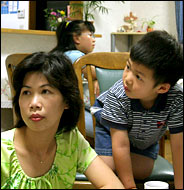Labor Migration to
Glenda S. Roberts
This set of papers is adapted from the panel, “Labor Migration to
with her daughter, Ai, and son, Jun, in the family’s house.
They adapted Japanese names.
Does the impending population decline inevitably mean
Deborah Milly’s paper spans her research on other countries in demographic decline—
The sense of crisis over immigration stems not only from the projections of a much smaller population in Japan, possibly leading to economic malaise, labor shortages, and pension and healthcare budgetary problems, but also from the question of public safety and security in an age in which the percentage of foreign nationals and their diversity is increasing. Ryoko Yamamoto’s paper offers an insightful view into the discourse of criminality that hounds migrants in
Atsuko Abe utilizes questionnaire data to query the relationship between local governments and the foreign nationals in their midst. Are foreign residents perceived as a kind of ‘citizen’? Do local governments use multi-lingual services to reach out to foreign residents? As Abe herself notes, foreign residents are a diverse group, in terms of origin as well as occupation, length of residency, knowledge of Japanese language and social institutions, and connections to the Japanese community. Her research finds that local governments, especially those with larger foreign-resident populations, do respond with programs to try to support them in their lives in Japan, and that some local governments bypass the prefectural level altogether to work with migrants. ‘Multicultural co-existence,’ however, seems to be very much a question, with little consensus over how far foreign residents should be required to assimilate. Abe relates that Multi-cultural Co-existence has become an official policy, but how do people view ‘multiculturalism’ on the ground? This will be an important issue to follow in the coming years. The issues raised in these papers will continue to be salient as
[1] OECD (2003): Stocks of foreign and foreign-born populations in selected OECD countries, 1995 and 2002. http://www.oecd.org/dataoecd/7/49/24994376.pdf (found 1 December 2006).
[2] Roberts, Glenda S. Forthcoming. “Fewer Japanese, More Immigrants? Migration Frameworks and Policy Challenges”, in Coulmas, Florian; Conrad, Harald; Schad-Seifert, Annette; Vogt, Gabriele (eds.)The Demographic Challenge. A Handbook about
Glenda S. Roberts is a Visiting Fellow at the Department of Anthropology, Yale University, and Professor at the Graduate School of Asia-Pacific Studies,






